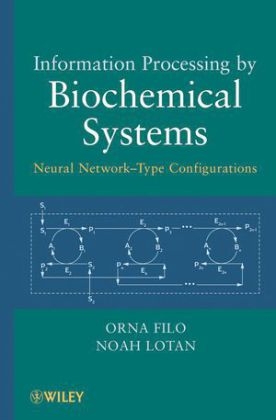
Information Processing by Biochemical Systems
John Wiley & Sons Inc (Verlag)
978-0-470-50094-1 (ISBN)
A Research-Driven Resource on Building Biochemical Systems to Perform Information Processing Functions Information Processing by Biochemical Systems describes fully delineated biochemical systems, organized as neural network–type assemblies. It explains the relationship between these two apparently unrelated fields, revealing how biochemical systems have the advantage of using the "language" of the physiological processes and, therefore, can be organized into the neural network–type assemblies, much in the way that natural biosystems are. A wealth of information is included concerning both the experimental aspects (such as materials and equipment used) and the computational procedures involved. This authoritative reference:
Addresses network-type connectivity, considered to be a key feature underlying the information processing ability of the brain
Describes novel scientific achievements, and serves as an aid for those interested in further developing biochemical systems that will perform information-processing functions
Provides a viable approach for furthering progress in the area of molecular electronics and biocomputing
Includes results obtained in experimental studies involving a variety of real enzyme systems
Information Processing by Biochemical Systems is intended for graduate students and professionals, as well as biotechnologists.
ORNA FILO, PhD, has over ten years of experience in the medical equipment industry, developing various diagnostic imaging technologies. She held various positions in R&D and clinical affairs, including management of clinical studies, clinical support to R&D and marketing, development of clinical studies protocols, and data analysis. Dr. Filo currently owns a company that develops tools for assessment of spine deformities. NOAH LOTAN, PhD, is a chemical engineer by basic training. He was appointed Professor of Biomedical Engineering at the Technion – Israel Institute of Technology. Dr. Lotan has been a visiting scientist at universities in the United States, France, Germany, Italy, Switzerland, the United Kingdom, and Mexico.
Preface. Terminology.
List of Symbols and Acronyms.
1 Introduction and Literature Survey.
1.1 Introduction.
1.2 Computational Processes Based on Biological Principles.
1.2.1 Modeling Biological Processes.
1.2.2 Artificial Neural Networks.
1.3 Molecular and Biomolecular Electronics.
1.3.1 Motivation.
1.3.2 Molecular Electronics.
1.3.3 Biomolecular Electronics.
1.4 Biochemical Devices Based on Enzymic Reactions.
1.5 Oscillations in Biochemical Systems.
1.6 Kinetic Characteristics of Cyclic Enzyme Systems.
2 Background and Goals of This Study.
3 Materials and Methods.
3.1 Materials.
3.2 Instruments.
3.3 Experimental Methods.
3.3.1 Determination of Kinetic Constants.
3.3.2 Determination of the Inhibition Constant for Inhibition of Glutathione Reductase by Glucose-6-Phosphate.
3.3.3 Immobilization on Affi-Gel 10.
3.3.4 Assay for Glucose-6-Phosphate Dehydrogenase.
3.3.5 Assay for Glutathione Reductase.
3.4 Computational Methods.
4 Results.
4.1 The Basic System: Theoretical Considerations and Results.
4.1.1 Characteristics of the Basic System.
4.1.2 The Basic System as an Information-Processing Unit.
4.1.3 Analytical Models for the Basic System.
4.1.4 Results of Numerical Simulations for the Basic System.
4.2 Neural Network–Type Biochemical Systems for Information Processing.
4.2.1 Network A.
4.2.2 Network B.
4.2.3 Network C.
4.3 The Basic System: Experimental Results.
4.3.1 Deciding on the Experimental System.
4.3.2 Kinetic Study of the Experimental System.
4.3.3 Control of the Input Signal.
4.3.4 The Basic System in a Fed-Batch Reactor.
4.3.5 Internal Inhibition in the Basic System.
4.3.6 Prediction of the Analytical Model Considering Internal Inhibition in a Fed-Batch Reactor.
4.3.7 Immobilization of G6PDH and GR.
4.3.8 The Basic System in a Packed Bed Reactor.
4.4 The Extended Basic System: Theoretical Considerations and Results.
4.4.1 Characteristics of the Extended Basic System.
4.4.2 The Extended Basic System as an Information-Processing Unit.
4.4.3 Analytical Model for the Extended Basic System.
4.4.4 Results of Numerical Simulations for the Extended Basic System.
5 Discussion.
5.1 The Basic System.
5.1.1 Fed-Batch Reactor: Numerical Simulations.
5.1.2 Continuous Reactor: Numerical Simulations.
5.1.3 Assessment of Experimental Results.
5.2 The Extended Basic System.
5.3 Biochemical Networks.
5.4 Comparing Artificial Neural Networks with Biochemical Networks.
5.5 Comparing Biochemical Networks to Computational Models.
6 Conclusions.
References.
Index.
| Zusatzinfo | Drawings: 85 B&W, 0 Color; Tables: 18 B&W, 0 Color |
|---|---|
| Verlagsort | New York |
| Sprache | englisch |
| Maße | 163 x 241 mm |
| Gewicht | 408 g |
| Einbandart | gebunden |
| Themenwelt | Informatik ► Theorie / Studium ► Künstliche Intelligenz / Robotik |
| Naturwissenschaften ► Biologie | |
| Naturwissenschaften ► Chemie | |
| Technik ► Elektrotechnik / Energietechnik | |
| ISBN-10 | 0-470-50094-8 / 0470500948 |
| ISBN-13 | 978-0-470-50094-1 / 9780470500941 |
| Zustand | Neuware |
| Haben Sie eine Frage zum Produkt? |
aus dem Bereich


